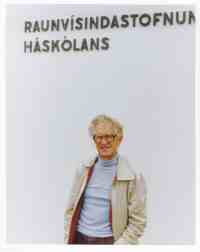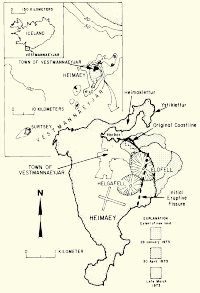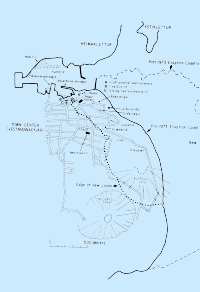Lava-Cooling Operations During the 1973 Eruption of Eldfell Volcano,
Heimaey, Vestmannaeyjar, Iceland
U.S. Geological Survey Open-File Report 97-724
|
|
by Richard S. William, Jr.
Diversion of Lava Flows: A Brief Review
In order to protect public and private property from being destroyed by lava flows, various plans and actual attempts have been made in the past on volcanoes to stop or divert lava flows, including Mount Etna, Sicily, Italy; Kilauea and Mauna Loa volcanoes, Hawaii, Hawaii,and Eldfell volcano, Heimaey, Vestmannaeyjar, Iceland (Bolt and others, 1977; Blong, 1984; Appendix No. 2). The lava-cooling operations on Heimaey, Iceland, were, however, the most extensive ever attempted, and the two excellent accounts of the operations that were published in Icelandic by a geophysicist and two engineers are translated into English in this open-file report. Birgir Jónsson (1993) also published a report on the use of dikes to divert lava flows; he mentioned past attempts in Italy, Japan, Iceland, Samoa, and Hawaii, but devoted most of his paper to presenting a case study of the 1973 eruption on Heimaey.
Lava-diversion attempts have been carried out in Hawaii on several occasions (Moore, 1982; Macdonald, 1972; Macdonald and others, 1986; Lockwood and Romano, 1985; Heliker, 1992; Appendix No. 2). The U.S. Army Air Corps carried out aerial bombing of lava flows from Mauna Loa in 1935 and 1942; the results were considered inconclusive, because the lava flow stopped at about the same time as the bombing operations. On 1 December 1975, 8 April 1976, and 4-5 May 1976, the U.S. Air Force carried out bombing experiments on Mauna Loa lava flows and craters using various types and sizes of bombs.
Moore (1982), in a U.S. Geological Survey open-file report, discusses lava-diversion barriers on Mauna Loa volcano and provides a comprehensive list of references pertaining to diversion of lava flows in Hawaii. The 1986 and 1987 effusive eruptions from Pu'u O'o on the East Rift Zone of the Kilauea Volcano Hawaii, destroyed several homes in the Kalapana area. In November 1986, attempts were made by local firemen to prematurely chill and divert lava flows around one home by spraying freshwater from the municipal water system onto the advancing margin (John Lockwood, 1987, personal communication), but the attempt failed because of the volume of lava. [As of late 1997, lava flows from the East Rift Zone continue to overrun homes and land in Kalapana and environs.]
Translation of Icelandic Reports
Because of the success of the Icelanders in their massive lava-cooling operations during the 1973 eruption of Eldfell volcano within the town of Vestmannaeyjar, on the island of Heimaey, in the Vestmannaeyjar archipelago, Iceland, I decided that English translations of two relevant reports by Icelandic scientists and engineers on the lava-cooling operations would be useful to volcanically active regions, where access to water (river, lake, or ocean) could provide the basis for lava-cooling operations. Several developed locations on the island of Hawaii could be candidates, including lava flows from Mauna Loa into Hilo and environs, lava flows from Hualalai along the Kona coast, etc. The two translations, one from a newspaper article, the other from an engineering journal, provide English-speaking scientists access to these important reports.
|
|
Figure 1. Click on figure for larger image with caption. |
The first report appeared in the Reykjavik newspaper Tíminn [The Times] on Saturday, 19 January 1974, pages 8, 9, and 13 (Þorbjörn Sigurgeirsson, 1974). The newspaper article is based on a lecture given by Prof. Thorbjörn Sigurgeirsson (1917-1988) at the Nordic House (Norrænna húsið) in Reykjavík, Iceland, on 4 November 1973, approximately 4 months after eruptive activity ceased on the island of Heimaey, Vestmannaeyjar, Iceland (fig.1). Thorbjörn Sigurgeirsson, in January 1967, had previously carried out limited experiments on the north coast of Surtsey, Vestmannaeyjar, where water was sprayed onto a lava flow that was advancing into a lagoon near the scientific observation hut, Pálsbær [named for Prof. Paul S. Bauer (1904-1977) of American University, Washington, DC, co-founder and financial benefactor of the Surtsey Research Society]; the experiment proved that an advancing lava-flow front could be prematurely solidified, thereby impeding further advance of the lava as long as the flow rate was not too high. When the volcanic eruption on Heimaey threatened the town of Vestmannaeyjar, and it appeared likely that the harbor would be closed off by lava flows, Thorbjörn Sigurgeirsson became a strong proponent of spraying sea water on the lava flows to prematurely cool the lava flow fronts. The congealed lava would perhaps create a barrier to the upstream lavas, thereby sparing the harbor and also lessening the damage to public and private structures in Vestmannaeyjar.
|
|
Figure 2. Click on figure for larger image with caption. |
In his lecture, Thorbjörn Sigurgeirsson, who, at the time, was a professor of physics at the University of Iceland's Science Institute, draws from his personal observations and experiences during the course of the catastrophic volcanic eruption on Heimaey between 23 January 1973 (start of the eruption) and early July 1973 (end of the eruption). The lava-cooling operation began on 7 February 1973, and ended on 10 July 1973. The original lecture published in Tíminn included five photographs. Figure 2 and figure 3 are index maps to the volcanic archipelago (Vestmannaeyjar) and Heimaey and to the Town of Vestmannaeyjar on Heimaey, respectively, that I have included in this introduction to provide reference maps for scientists unfamiliar with the geography of Heimaey and its geographic place-names. Thorbjörn Sigurgeirsson (1974) also published an account in English about the lava cooling operations on Heimaey in a travel magazine.
|
|
Figure 3. Click on figure for larger image with caption. |
The second report is a technical paper by the engineers, Valdimar Kr. Jónsson and Matthías Matthíasson, that was published in the Tímarit Verkfræðingafélags Íslands [Journal of the Icelandic Association of Chartered Engineers] in 1974 (Valdimar Kr. Jónsson and Matthías Matthíasson, 1974). Their paper is the best and most complete description available of the technical aspects of the water-cooling operations on Heimaey, during 1973. At the end of their paper are translations of the editorial comments by Páll Lúðvíksson, Editor of the journal, and brief biographical sketches of the two authors, all of which were included in v. 59, no. 5, of Tímarit Verkfræðingafélags Íslands (Appendix No. 1).
The lecture on "Lava Cooling" by Thorbjörn Sigurgeirsson and the companion journal article, "Lava Cooling on Heimaey - Methods and Procedures," by Valdimar Kr. Jónsson and Matthías Matthíasson, aside from their significant contributions to scientific-and-engineering knowledge of the effect of water on the rate and process of cooling of lava flows, have had an important practical application. Knowledge gained from the water-cooling operation during 1973 was directly applied to the construction of a district-heating system for the town of Vestmannaeyjar on Heimaey, in which thermal energy was extracted from the cooling lavas. During the latter part of 1973 and early 1974, scientists and engineers from the University of Iceland, residents of Vestmannaeyjar, and the Icelandic engineering firm, Verkfræðistofa Guðmundar og Kristjáns hf., prepared the conceptual basis for the creation of the district-heating system. Initial experiments were begun in 1974, but it was not until late 1979 that the final engineering design for the system was approved.
By 1983, a 5 megawatt heat-exchanger plant, in which steam produced by spraying water on cooling lava flows at depth in the eastern part of the new lava flows, was circulating hot water to more than 50 percent of the buildings in Vestmannaeyjar. As with the record of the 1973 lava-cooling operations on Heimaey, most of the literature written about the district heating system is only available in Icelandic. A brief, illustrated summary of the system is included in the second edition of the U.S. Geological Survey scientific leaflet, "Man Against Volcano: The Eruption on Heimaey, Vestmannaeyjar, Iceland" (Williams and Moore, 1983) and available at the following URL address: "https://pubs.usgs.gov/gip/heimaey", in an article and a paper by Sveinbjörn Björnsson (1980, 1987), in an unpublished mimeographed report (Anonymous, 1982), and in a paper by Þorbjörn Sigurgeirsson (1982). An Icelandic-English Glossary of Geoscience Terms is also available at the following URL address: "http://woodshole.er.usgs.gov/epubs/rwilliams/geoicelandic.html"
John McPhee's Account
John McPhee, a well-known natural-history and science writer, took a special interest in the cooling of the lava flows on Heimaey from the viewpoint of interaction of human activities with volcanic processes and from the perspective of the many individuals, scientists and laypersons, whose lives were touched by the Eldfell eruption. McPhee (1988 a, b) wrote a two-part article for The New Yorker magazine; the articles were later combined to make a chapter in one of his books (McPhee, 1989).
Movies about the Eldfell Eruption
Several movies about the 1973 volcanic eruption on Heimaey have been made, including two half-hour films by professional cinematographers and several by amateurs (field scientists); only one of the amateur films is included in the synopses of the three half-hour films provided in the following section.
Days of Destruction (27 min.)
Producer: Kvikmyndagerðin Hljóð og mynd, Skúlagötu 61,
IS-101 Reykjavík, Iceland;
color, sound, English narration.
The film chronicles the eruption on Heimaey in 1973 and the effect it had on the inhabitants of the prosperous fishing village. The footage, depicting the eruption, lava flow, and tephra fall is excellent. A good deal of the film concerns the problems of the citizenry faced throughout the duration of the eruption. These include relocation, salvage of personal property, damage to buildings caused by fire, tephra fall, and advancing lava, and the possible obstruction of the harbor mouth by the advance of the lava. While there is some lack of scientific data, the shock and pain experienced by the islanders is transmitted exceptionally well by the film. The film ends with the unanswered question of what the former inhabitants of Heimaey are to do in the future.
Fire on Heimaey (Eldur í Heimaey) (28 min.)
Producer: VÓK-Film hf., Hellusundi 6A, IS-101 Reykjavík, Iceland;
color, sound,
English narration;
available also in videocassette format.
The film covers the same event as Days of Destruction, above, but goes farther chronologically. The major difference between these two films is the extent to which the problems of the inhabitants of Heimaey are covered. This film spends less time on that, concentrating more on the physical phenomena of the eruption. The human element is included but not belabored. The struggle of the Icelanders to halt the advance of the lava and save the town is documented. A great advantage that this film has over the other is that it includes reclamation efforts begun by the Icelanders after the eruption ended. This film ended on a definitely optimistic tone, with the prodigious efforts to reclaim the town proving successful. This film is by far the most complete one covering the 1973 Heimaey eruption. Along with superb photography by the late Ósvaldur Knudsen, is the excellent commentary, written by the late Próf. Sigurður Thórarinsson, the famed Icelandic geomorphologist and tephrochronologist.
The Heimaey Eruption: Iceland 1973 (28 min.)
Producer: Prof. Alan V. Morgan, Department of Earth Sciences,
University of Waterloo, Waterloo, Ontario N2L 3GI Canada;
color, sound, English narration; available also in videocassette format.
The film portrays some of the events following the eruption of the volcano Eldfell in 1973 on the island of Heimaey off the south coast of Iceland. The film was made in three sections; the first depicting the town of Vestmannaeyjar at the end of January shortly after the 5,000 inhabitants had been evacuated. The second section illustrates scenes in mid-April, approximately two weeks after a major lava surge had destroyed a large part of the town. The third part shows the recovery made by the islanders in mid-July. The spacing of the film sections was deliberately set at three-month intervals.
Acknowledgements
The editor would like to acknowledge the technical reviews of and suggested additions to the Introduction and two translations by Sveinbjörn Björnsson, University of Iceland; Henry J. Moore, U.S. Geological Survey; and especially Oddur Sigurðsson, National Energy Authority, who markedly improved the translation of the article by Þorbjörn Sigurgeirsson. Sigrún Rockmaker did her usual superb translation of the technical paper by Valdimar Kr. Jónsson and Matthías Matthíasson.
References
Anonymous, 1982, Hraunhitinn og virkjun hans [Lava heating and its development]: mimeographed report from the Science Institute, University of Iceland, Reykjavík, 8 p.
Björnsson, Sveinbjörn, 1980, Natural heat saves millions of barrels of oil: Unique procedures developed by Icelanders - they even tap hot lava: Atlantica and Iceland Review, v. 18, no. 1, p. 28—37.
Blong, R.J., 1984, Volcanic hazards. A sourcebook on the effects of eruptions: New York, Academic Press, 424 p. (See especially p. 189—201, Lava Flows).
Bolt, B.A., Horn, W.L., Macdonald, G.A., and Scott, R.F., 1977, Geological hazards, earthquakes--tsunamis--volcanoes--avalanches--landslides--floods: revised second edition, New York, Springer-Verlang, 330 p. (see especially p. 87-93, Control of Flows).
Björnsson, Sveinbjörn, 1987, Kólnun Eldfellshrauns og nýting hraunhita [The cooling of the Eldfell lava and utilization of its heat]: in Í Hlutarins Eðli: Reykjavík, Menningarsjóður, p. 301–321.
Eyjlfsson, Guðjón Ármann, 1974, Vestmannaeyjar. Byggð og eldgos [Settlement and eruption]; Önnur Prentum [2nd printing]: Reykjavík, Ísafoldarprentsmiðjan.
Heliker, Christina, 1992, Volcanic and seismic hazards on the Island of Hawaii: U.S. Geological Survey Scientific Booklet, 48 p.
National Land Survey of Iceland, 1973a, Vestmannaeyjakaupstaður (Town of Vestmannaeyjar): Orthophotomap (15 July 1971), scale 1:5,000.
——1973b, Vestmannaeyjar: Special edition of the Danish Geodetic Institute map of Vestmannaeyjar, scale 1;50,000. Includes two inset maps, a 1:14,000-scale aerial photograph (15 July 1971) and a 1:10,000-scale planimetric map of Vestmannaeyjakaupstaður (Town of Vestmannaeyjar, ca. 1948). Both the 1:14,000-scale aerial photograph and the 1:50,000 topographic map are overprinted with the location of the initial NNE-trending eruptive fissure on the east side of Heimaey.
——1979, Vestmannaeyjar: Special map of the Vestmannaeyjar archipelago, scale 1:50,000, including topographic map of the islands and an orthophotomap (27 July 1977) of the town of Vestmannaeyjar, scale 1:10,000.
Jónsson, Birgir, 1993, The role of man-made dykes in diverting lava flows. Case study: The Heimaey eruption 1973: in Proceedings of the International Conference on Preparedness and Mitigation for Natural Disasters '92 (Reykjavík, Iceland; 28-29 May 1992).
Jónsson, Valdimar Kr., and Matthíasson, Matthías, 1974, Hraunkæling á Heimaey - Verklegarframkvæmdir [Lava cooling on Heimaey - methods and procedures]: Tímarit Verkfræðingafélags Íslands, v. 59, no. 5, p. 70-81 and p. 83.
Lockwood, J.P., and Romano, Romolo, 1985, Diversion of lava during the 1983 eruption of Mount Etna: Earthquake Information Bulletin, v. 17, no. 4, p. 124–133.
Macdonald, G.A. 1972, Volcanoes: Englewood Cliffs, N.J., Prentice-Hall, 510 p. [see especially p. 419–422].
Macdonald, G.A., Abbott, A.T., and Peterson, F.L., 1986, Volcanoes in the sea. The geology of Hawaii: Second Edition, Honolulu, University of Hawaii Press, 517 p. [see especially p. 168–172, Control of Flows].
McPhee, John, 1988a, The control of nature (Volcano-Part I): in The New Yorker (22 February 1988), p. 43–58.
——1988b, The control of nature (Volcano-Part II): in The New Yorker (28 February 1988), p. 64–77.
——1989, Cooling the lava; in The control of nature: New York, Farrar Straus Giroux, p. 95–179.
Moore, H.J., 1982, A geologic evaluation of proposed lava diversion barriers for the Mauna Loa Observatory, Mauna Loa Volcano, Hawaii: U.S. Geological Survey Open-File Report 82–314, 17 p. (with three map plates).
Þorbjörn Sigurgeirsson, 1974, Hraunkæling [Lava cooling]: Tíminn, 19 January 1974, p. 8-9 and p. 13.
——1982, Hagnýting hraunhita [utilization of heat from lava] in Eldur er í Norðri: Reykjavík, Sögufélag hf., p. 437-441.
Sigurgeirsson, Thorbjörn, 1974, The battle of Heimaey; in Ísland 1974, Welcome to Iceland: Denmark, Anders Nyborg A/S, p. 63, 64, 66, 68–69, and 71.
Thorarinsson, Sigurdur, 1967, Surtsey - The new island in the North Atlantic: New York, Viking Press, 110 p.
Williams, R.S., Jr., and Moore, J.G., 1976a, Man against volcano: The eruption on Heimaey, Vestmann Islands, Iceland: U.S. Geological Survey Scientific Leaflet, 20 p.
——1976b, Iceland chills a lava flow: in Tank, Ronald, editor, Focus on environmental geology - A collection of case histories and readings from original sources: 2nd edition, New York, Oxford University Press, p. 49–58.
——1983, Man against volcano: The eruption on Heimaey: Vestmannaeyjar, Iceland: U.S. Geological Survey Scientific Booklet Revised Second Edition, 32 p. URL: "https://pubs.usgs.gov/gip/heimaey/"
Metric Units of Measurement
The metric units used in this publication can be converted to English units by using the approximate conversions given below:
Length
1 kilometer (km) = 0.62 miles (mi)
1 meter (m) = 3.28 feet (ft)
Volume
1 liter (l) = 0.035 cubic feet (ft3)
1 cubic meter (m3) = 35.3 cubic feet (ft3)
Area
1 square kilometer (km2) = 0.386 square miles (mi2)
1 square meter (m2) = 10.76 square feet (ft2)
Mass
1 kilogram (kg) = 2.2 pounds (lb)
1 tonne (t) = 2,200 pounds (lb)
Flow
1 liter per second (l s-1) = 0.035 cubic feet per second (ft3 s-1)
1 cubic meter per second (m3 s-1) = 35.3 cubic feet per second (ft3 s-1)
Temperature
To convert ºCelsius to ºFahrenheit, multiply ºC by 1.8 and add 32


